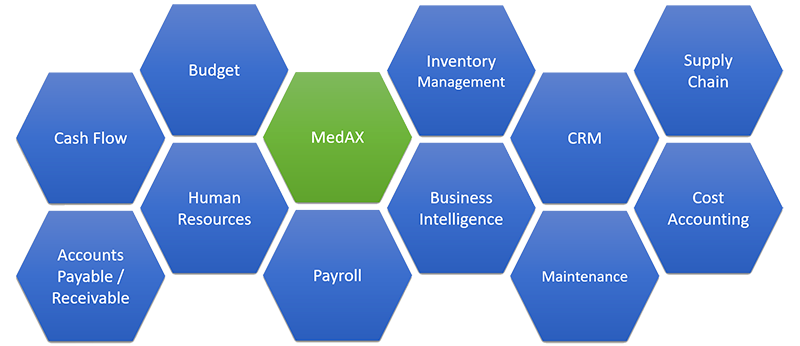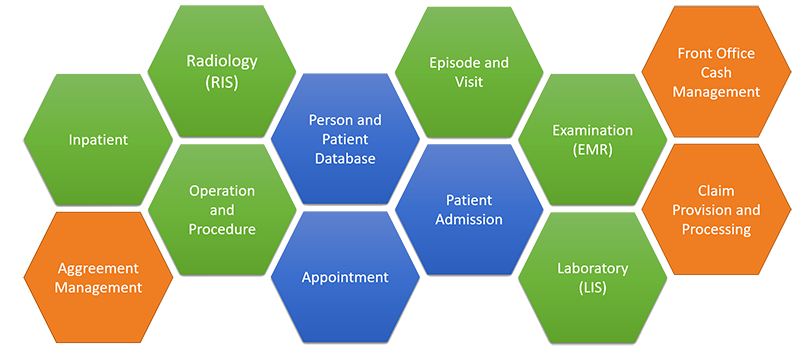Overview
MedAX is a complete HIS (Hospital Information System) developed and positioned in Microsoft D365 for Financials and Operations as an ERP module.
MedAX enables healthcare organizations to connect strategy with operational execution, manage trends and performance, optimize and align resources, connect disparate technologies, and deliver actionable insight and intelligence.


MedAX is explicitly designed for healthcare, which means it offers the broadest, deepest solutions for all organizations that serve the healthcare delivery model.
MedAX is not a third-party hospital information management system integrated with an ERP, but fully developed in and for Microsoft Dynamics 365.
Business Functionalities
General Inpatient System – Patient admittance and discharge, Room planning, Nursing station with patients overview, Treatment/monitoring and medicine orders, Integration with internal LIS and RIS, Doctor and nurse tracing data, medical reports, discharge reports; CPOE & Dietary, Critical Care
General Outpatient System – Exam schedule, Assistants stations, Assistant doctor support, Integration with internal LIS and RIS; Prescription, medical reports, Diagnosis based on ICD10 and scheduling following actions (operation indication and appointment)
Clinical Applications – All services represented with base medical meanings which can be extended with any clinical need; Any service or service request triggers clinical workflows based on these base or extended medical meanings; Base medical meanings contains Exams, operations, tests, studies, periodic services, etc.; Any base medical meaning can be extended and customized by different clinical needs without compromising front and back office processes like pricing or billing
EMR – All medical information is cored by widely designed database; In every step of treatment stared at request and planning phase to final assessment and result recording, nature of task, notes of every medical staff, any related medical information is stored with patient’s, staff’s and equipment etc. Ids and timestamps; All operations can be maintained paperless
Decision Support – Both inpatient and outpatient modules supply doctors and other medical staff a wide information representing patients current and all past medical information; Internal LIS module tracks and supply medical staff detailed information about patients past test results, reference and critical values related on patient’s gender, age and current medical condition. supports alerts related to test results; Both internal LIS and RIS module supplies detail clinical information about patient to related medical staff; Automated and hand filled medical history tracks patient surgery, self and family history, allergies, etc. and supplies this information to medical staff as needed.
Patient Billing – Supports multiple periodic price lists for services and materials; Price lists can be differential for facilities, doctor groups, etc.; Price calculations automated trough social security agency and insurance company agreements with a highly sophisticated engine; Includes campaign management, loyalty cards, etc.; Each treatment case can be priced and billed to several parties based on agreement rules; Supports detailed, briefed and merged billing
Pharmacy – Medicine inventory can be traced in different locations; Support for serial numbers and expiration dates; Support for 1D and 2D barcode systems; Patients orders can be traced, prescriptions for patients can be generated and transferred to responsible departments, schedules for the orders can be monitored and altered by the pharmacy
Revenue Cycle Applications – Pricing and service rules like provision, control periods, mandatory paper forms, etc. defined by agreements are tracked and force in every step of patient’s visit. These definitions keep patients file billable all time and avoids forfeit; Supports periodic billing case management; Gives brief and detailed information to management and corresponding departments about cash flow by tracking all billing and payment transactions
Surgery/OR Management – Indications collected from outpatient and inpatient system can be monitored and surgery request can be generated based on that information; Surgery schedules can be made including detail information and planning for operators, anesthesiologists, support personnel, surgery room, equipment and materials; Staff and room performance can be monitored; Surgery results are filled separately with actual crew, room, equipment and material data without changing the original plan data; Supports multiple clinic and crew for single operating sessions and sessions can be related to each other
Staff Scheduling – Detailed resource planning system tracks every personnel’s schedule including doctors, nurses, technicians and other supports personnel; Any area in facility like patient and surgery rooms, etc. can be defined and traced by RP module; Any equipment can be defined and traced by RP module; For every resource working and non-working time charts can be defined with service type detail
Technical Functionalities and Features
General Structure – Microsoft Dynamics 365 is a three tire ERP application with database-application server-client tires. Basically an up-level development environment with a data and object oriented language and an UI design system. All modules including MedAX and other ERP modules are relies as an open source application in that environment and can be fully customized through user’s needs.
Development Audits – Microsoft Dynamics 365 support multiple version control systems. On site development activities can be audit able over version control systems. All code changes include upgrades from Microsoft and ETG are fully transparent and audit able before applying to system.
Disaster Recovery – All data and business logic stored in Microsoft SQL server which has wide disaster recovery policies; N-tier architecture allows sizing on server level and give opportunity user Windows servers clustering and disaster recovery tools and policies
Localization – Multi language; Globally local support at any region
Security – Microsoft Active Directory integrated; Highly sophisticated inner security system defined as tasks, task groups, roles, privileges etc. ; Action and form security; Table security with columns and rows with different access levels ; Supports delegation; Supports non enterprise users and proxy authentication
Security Audits –Microsoft Dynamics 365 has built in “Compliance and Internal Controls” module has ability to trace user security configurations.
Testing / Upgrades – Microsoft Dynamics 365 multi-layered development environment allows applying any upgrades supplied by Microsoft or MedAX without compromising customer site customization and implementation; Both Microsoft and ETG has road maps for applications and beta testing program
Tracing history – Audit trail data export capability; Any data including definitions, main and transaction data can be traced by change tracking system with user and timestamp information; Microsoft Dynamics 365 has built in database logging system. All activity can be logged per user and per table basis and selectively by transaction type, conditions on data itself.
User Interface – Microsoft Dynamics 365 Rich Client for on-prem; Any internet browser; Mobile Device Framework
Network and Network Interface – RPC based communication between application servers and rich client; WCF interface for integration purposes; Cloud; Microsoft Azure
Hardware, Operating System and Underlying Software – Microsoft Azure, on-prem, cloud
Database- Microsoft SQL Server
Gain in Productivity and Functionality
By pre-implementing Dynamics 365 aware of health operations we extend quality and functionality for
RESOURCE MANAGEMENT
Human Resource, Facility Resource, Equipment Resource
INVENTORY MANAGEMENT
Medical supply and pharmacy
COST MANAGEMENT
Medical Surgery Operation Cost
REVENUE CYCLE MANAGEMENT
Revenue Generation – Free Cash Flow – Payments
MedAX Value Adds
By covering HIS role within ERP pre-integrated with EMRs
Cost Saving
Less IT resource to monitor and maintain for the same platformLicense and Project Cost Saving
Both ERP project and HIS project is done in the same project implementation
Unified Operation
Having HIS as a module in ERP removes one major integration work outExtend Productivity and Functionality
Reduce number software to maintain and reduce number of integration to maintain
Democrotizing
Reduce total costs by extending product/project life time for customerReachable
Having product reachable by small and medium size customers
Our Approach
We know that the most successful consulting engagements begin with our respectful approach and commitment to understanding your corporate culture and the nuances of your business.
Our Values
We believe that the professional service we are doing for our clients makes a significant difference to them.
Our strategy
Everything we do is tailored for you: your business, your need, your goals, and your future.

